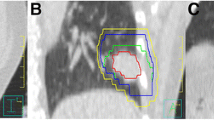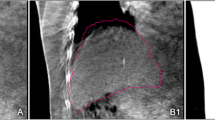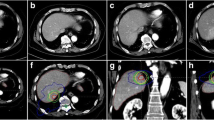Abstract
Purpose
The purpose of this work was to investigate the potential of lipiodol as a direct tumor surrogate alternative to the diaphragm surrogate on four-dimensional cone-beam computed tomography (4D-CBCT) image guidance for stereotactic radiotherapy of hepatocellular carcinomas.
Methods
A total of 29 hepatocellular carcinomas (HCC) patients treated by stereotactic radiotherapy following transarterial chemoembolization (TACE) with homogeneous or partial defective lipiodol retention were included. In all, 4–7 pretreatment 4D-CBCT scans were selected for each patient. For each scan, either lipiodol or the diaphragm was used for 4D registration. Resulting lipiodol/diaphragm motion ranges and position errors relative to the reconstructed midventilation images were analyzed to obtain the motion variations, and group mean (ΔM), systematic (Σ), and random (σ) errors of the treatment setup.
Results
Of the lipiodolized tumors, 55 % qualified for direct localization on the 4D-CBCT. Significant correlations of lipiodol and diaphragm positions were found in the left–right (LR), craniocaudal (CC), and anteroposterior (AP) directions. ΔM and σ obtained with lipiodol and diaphragm were similar, agreed to within 0.5 mm in the LR and AP, and 0.3 mm in the CC directions, and Σ differed by 1.4 (LR), 1.1 (CC), and 0.6 (AP) mm. Variations of diaphragm motion range > 5 mm were not observed with lipiodol and in one patient with diaphragm. The margin required for the tumor prediction error using the diaphragm surrogate was 6.7 (LR), 11.7 (CC), and 4.1 (AP) mm.
Conclusion
Image-guidance combining lipiodol with 4D-CBCT enabled accurate localization of HCC and thus margin reduction. A major limitation was the degraded lipiodol contrast on 4D-CBCT.
Zusammenfassung
Hintergrund
Ziel dieser Studie war es, das Potential von Lipiodol als direktes Tumorsurrogat alternativ zum Zwerchfellsurrogat für die vierdimensionale Cone-beam-Computertomographie (4D-CBCT) in der stereotaktischen Strahlentherapie von hepatozellulären Karzinomen (HCC) zu analysieren.
Methoden
Eingeschlossen wurden 29 HCC-Patienten, die mittels stereotaktischer Strahlentherapie nach transarterieller Chemoembolisation (TACE) mit homogener oder teilweise defekter Lipiodolspeicherung behandelt wurden. Für jeden Patienten wurden 4–7 4D-CBCT-Scans vor der Behandlung ausgewählt. Für jeden Scan wurde eine 4-D-Registrierung unter Verwendung von Lipiodol oder Zwerchfell als Registrierungsmaske durchgeführt. Die resultierenden Lipiodol- bzw. Zwerchfellbewegungen und Positionsfehler relativ zu den rekonstruierten MidP-Bildern (MidV, midventilation images) wurden analysiert, um Veränderungen in den Bewegungen, Gruppen- (ΔM), systematische (Σ) und zufällige (σ) Fehler in der Patientenlagerung sowie notwendige Sicherheitssäume (M) beurteilen zu können.
Ergebnisse
Für die direkte Lokalisierung auf den 4D-CBCT waren 55 % der Tumoren mit Lipiodol geeignet. Signifikante Korrelationen von Lipiodol- und Zwerchfellpositionen wurden in links-rechts (LR), kraniokaudalen (CC) und anteroposterioren (AP) Richtungen gefunden. Die ΔM- und σ-Fehler mit Lipiodol und Zwerchfell stimmten mit Abweichungen von 0,5 mm in LR- und AP- sowie mit 0,3 mm in CC-Richtung überein; der Σ-Fehler unterschied sich um 1,4 mm (LR), 1,1 mm (CC) und 0,6 mm (AP). Veränderungen der Zwerchfellbewegung > 5 mm wurden bei keinem Patienten mit Lipiodol und bei einem Patienten mit Zwerchfell als Registrierungsmaske beobachtet. Der notwendige Sicherheitssaum, um den Tumorvorhersagefehler für das alleinige Zwerchfellsurrogat auszugleichen, betrug 6,7 mm (LR), 11,1 mm (CC) und 4,1 mm (AP).
Schlussfolgerung
Bildregistrierungsprotokolle mit Lipiodol in Kombination mit 4D-CBCT ermöglichen die genaue Lokalisierung von HCC und somit die signifikante Reduktion von Sicherheitssäumen. Haupteinschränkungen dieser Technik sind bereits abgebaute Lipiodolanreicherungen auf dem 4D-CBCT.






Similar content being viewed by others
References
Seppenwoolde Y, Wunderink W, Wunderink-van Veen SR, Storchi P, Méndez Romero A, Heijmen BJM (2011) Treatment precision of image-guided liver SBRT using implanted fiducial markers depends on marker-tumour distance. Phys Med Biol 56:5445–5468
Shin SW (2009) The current practice of transarterial chemoembolization for the treatment of hepatocellular carcinoma. Korean J Radiol 10:425–434
Yue J, Sun X, Cai J, Yin F-F, Yin Y, Zhu J, Lu J, Liu T, Yu J, Shi X, Song J (2012) Lipiodol: a potential direct surrogate for cone-beam computed tomography image guidance in radiotherapy of liver tumor. Int J Radiat Oncol Biol Phys 82:834–841. doi:10.1016/j.ijrobp.2010.12.050
Nakagawa K, Yamashita H, Igaki H, Terahara A, Shiraishi K, Yoda K (2008) Contrast medium-assisted stereotactic image-guided radiotherapy using kilovoltage cone-beam computed tomography. Radiat Med 26:570–572. doi:10.1007/s11604-008-0275-2
Sonke J-J, Zijp L, Remeijer P, van Herk M (2005) Respiratory correlated cone beam CT. Med Phys 32:1176–1186. doi:http://dx.doi.org/10.1118/1.1869074
Wolthaus J, Sonke J-J, Vanherk M, Belderbos J, Rossi M, Lebesque J, Damen E (2008) Comparison of different strategies to use four-dimensional computed tomography in treatment planning for lung cancer patients. Int J Radiat Oncol Biol Phys 70:1229–1238. doi:10.1016/j.ijrobp.2007.11.042
Sonke J-J, Rossi M, Wolthaus J, van Herk M, Damen E, Belderbos J (2009) Frameless stereotactic body radiotherapy for lung cancer using four-dimensional cone beam CT guidance. Int J Radiat Oncol Biol Phys 74:567–574. doi:10.1016/j.ijrobp.2008.08.004
Sonke J-J, Lebesque J, Vanherk M (2008) Variability of four-dimensional computed tomography patient models. Int J Radiat Oncol Biol Phys 70:590–598. doi:10.1016/j.ijrobp.2007.08.067
Case RB, Moseley DJ, Sonke JJ, Eccles CL, Dinniwell RE, Kim J, Bezjak A, Milosevic M, Brock KK, Dawson LA (2010) Interfraction and intrafraction changes in amplitude of breathing motion in stereotactic liver radiotherapy. Int J Radiat Oncol Biol Phys 77:918–925. doi:http://dx.doi.org/10.1016/j.ijrobp.2009.09.008
Case RB, Sonke J-J, Moseley DJ, Kim J, Brock KK, Dawson LA (2009) Inter- and intrafraction variability in liver position in non–breath-hold stereotactic body radiotherapy. Int J Radiat Oncol Biol Phys 75:302–308. doi:http://dx.doi.org/10.1016/j.ijrobp.2009.03.058
Srimathveeravalli G, Leger J, Ezell P, Maybody M, Gutta N, Solomon SB (2013) A study of porcine liver motion during respiration for improving targeting in image-guided needle placements. Int J Comput Assist Radiol Surg 8:15–27. doi:10.1007/s11548-012-0745-y
Yang J, Cai J, Wang H, Chang Z, Czito BG, Bashir MR, Palta M, Yin F-F (2014) Is diaphragm motion a good surrogate for liver tumor motion? Int J Radiat Oncol Biol Phys 90:952–958. doi:http://dx.doi.org/10.1016/j.ijrobp.2014.07.028
Chan MKH, Kwong DLW, Law GML, Tam E, Tong A, Lee V, Ng SCY (2013) Dosimetric evaluation of four-dimensional dose distributions of CyberKnife and volumetric-modulated arc radiotherapy in stereotactic body lung radiotherapy. J Appl Clin Med Phys 14:4229
Velec M, Moseley JL, Brock KK (2014) Simplified strategies to determine the mean respiratory position for liver radiation therapy planning. Pract Radiat Oncol 4:160–166
van Herk M, Remeijer P, Rasch C, Lebesque J (2000) The probability of correct target dosage: dose-population histograms for deriving treatment margins in radiotherapy. Int J Radiat Oncol Biol Phys 47:1121–1135
Chen M, Li J, Zhang Y, Lu L, Zhang W, Yuan Y, Guo Y, Lin X, Li G (2002) High-dose iodized oil transcatheter arterial chemoembolization for patients with large hepatocellular carcinoma. World J Gastroenterol 8:74–78
Jones BL, Altunbas C, Kavanagh B, Schefter T, Miften M (2014) Optimized dynamic contrast-enhanced cone-beam CT for target visualization during liver SBRT. J Phys Conf Ser 489:012035
Hawkins MA, Brock KK, Eccles C, Moseley D, Jaffray D, Dawson LA (2006) Assessment of residual error in liver position using kV cone-beam computed tomography for liver cancer high-precision radiation therapy. Int J Radiat Oncol Biol Phys 66:610–619. doi:http://dx.doi.org/10.1016/j.ijrobp.2006.03.026
Guckenberger M, Sweeney RA, Wilbert J, Krieger T, Richter A, Baier K, Mueller G, Sauer O, Flentje M (2008) Image-guided radiotherapy for liver cancer using respiratory-correlated computed tomography and cone-beam computed tomography. Int J Radiat Oncol Biol Phys 71:297–304. doi:10.1016/j.ijrobp.2008.01.005
Zhong R, Wang J, Jiang X, He Y, Zhang H, Chen N, Bai S, Xu F (2012) Hypofraction radiotherapy of liver tumor using cone beam computed tomography guidance combined with active breath control by long breath-holding. Radiother Oncol. doi:10.1016/j.radonc.2011.11.007
Eccles CL, Dawson LA, Moseley JL, Brock KK (2011) Interfraction liver shape variability and impact on GTV position during liver stereotactic radiotherapy using abdominal compression. Int J Radiat Oncol Biol Phys 80:938–946. doi:http://dx.doi.org/10.1016/j.ijrobp.2010.08.003
Brock KK, Hawkins M, Eccles C, Moseley JL, Moseley DJ, Jaffray DA, Dawson LA (2008) Improving image-guided target localization through deformable registration. Acta Oncol 47:1279–1285. doi:10.1080/02841860802256491
Author information
Authors and Affiliations
Corresponding author
Ethics declarations
Conflicts of interest
M.K.H. Chan, V. Lee, CL. Chiang, F.A.S. Lee, G. Law, N.Y. Sin, K.L. Sui, F.C.S. Wong, S.Y. Tung, H. Luk, and O. Blanck state that there are no conflicts of interest. Part of the results of this work has been presented at the ESTRO 3rd forum.
The accompanying manuscript does not include studies on humans or animals.
Rights and permissions
About this article
Cite this article
Chan, M., Lee, V., Chiang, C. et al. Lipiodol versus diaphragm in 4D-CBCT-guided stereotactic radiotherapy of hepatocellular carcinomas. Strahlenther Onkol 192, 92–101 (2016). https://doi.org/10.1007/s00066-015-0929-9
Received:
Accepted:
Published:
Issue Date:
DOI: https://doi.org/10.1007/s00066-015-0929-9
Keywords
- Image-guided radiotherapy
- 4D cone beam CT
- Stereotactic body radiotherapy
- Contrast media
- Planning techniques




